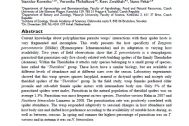Obsah
Current knowledge about polysphinctine parasite wasps’ interactions with their spider hosts is very fragmented and incomplete. This study presents the host specificity of Zatypota percontatoria (Müller) (Hymenoptera: Ichneumonidae) and its adaptation to varying host availability. Two years of field observations show that Z. percontatoria is a stenophagous parasitoid that parasitizes only five closely related web-building spiders of the family Theridiidae (Araneae). Within the Theridiidae it attacks only species belonging to a small group of species, here called the “Theridion” group. These hosts have a similar biology, but are available at different levels of abundance and at different sizes over the season. Laboratory experiments showed that this wasp species ignores linyphiid, araneid or dictynid spiders and accepts only theridiid spiders of the “Theridion” group. In the field study, wasp females preferred older juvenile and sub-adult female spider instars with intermediate body size. Only 5% of the parasitized spiders were males. Parasitism in the natural population of theridiid spiders was on average 1.3%. Parasitism was most frequent on two species, Theridion varians Hahn in 2007 and Neottiura bimaculata Linnaeus in 2008. The parasitization rate was positively correlated with spider abundance. The wasp responded adaptively to seasonal changes in host abundance and host body size and shifted host preference according to the availability of suitable hosts during, as well as between, seasons. In spring and summer the highest percentage of parasitism was on T. varians and in autumn it was on N. bimaculata.



